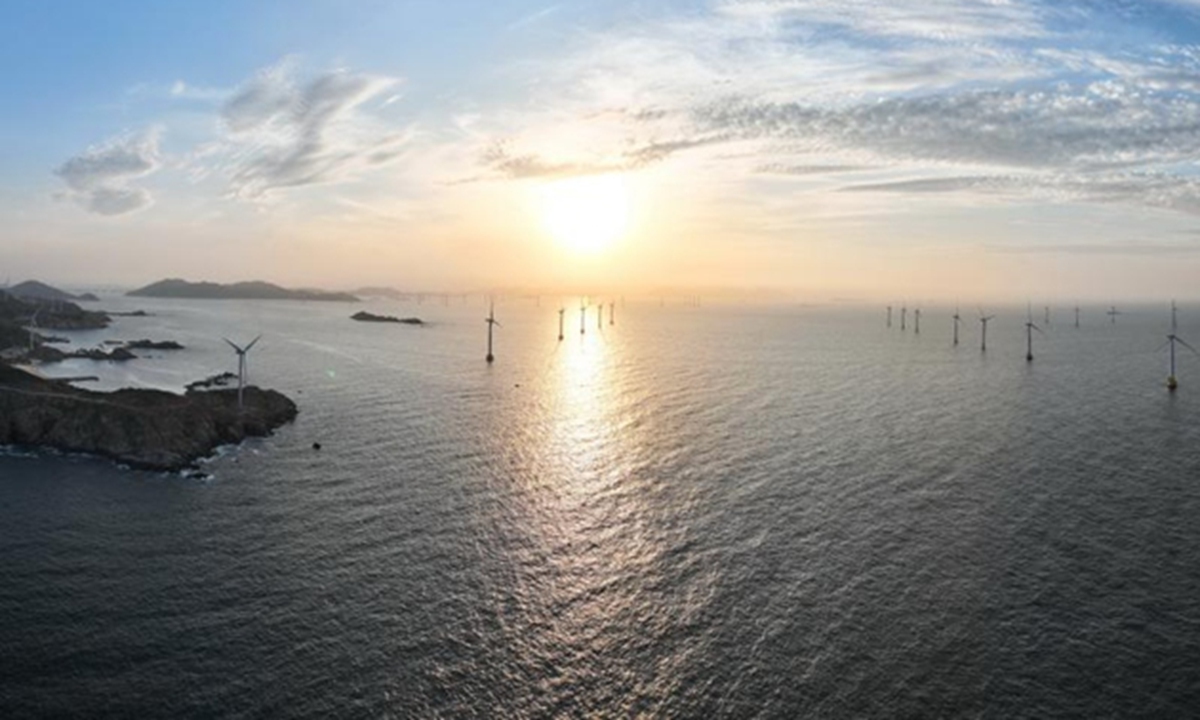White paper shows China’s progress in energy transition

An aerial drone photo taken on May 17, 2024, shows a wind farm off the coast of Pingtan County, southeast China's Fujian Province. In recent years, Fujian has accelerated the development of clean energy, including wind and nuclear power, to promote the green and low-carbon development of the society. (Photo: Xinhua)
China has made notable progress in energy transition over the past decade, with "historical breakthroughs" achieved in green and low-carbon energy development as the country is moving toward building a clean, diversified, secure, and resilient energy supply system, according to a white paper titled "China's Energy Transition" released by the State Council Information Office on Thursday.
The white paper listed an array of impressive figures that document milestones in China's energy transition in the past decade and highlight the country's outstanding contribution to the global green agenda. For example, last year, electricity generated by clean energy accounted for nearly 40 percent of China's total electricity generation. Also, the country's exports of wind and photovoltaic (PV) products helped other countries reduce carbon dioxide emissions by about 810 million tons in 2023.
Observers said that China's energy transition will play an exemplary role, illustrating a path that is cost-effective, economically feasible, and brings far-reaching effects to the global energy industry. It also proves that China's overwhelming edges in renewable energy stem from continuous innovation and a complete industrial chain, rather than certain Western fallacy of subsidies-driven growth.
The white paper also offers a detailed elaboration on China's commitment to fulfilling its responsibility as a major developing country as well as its willingness to work with other countries to keep global energy industrial and supply chains stable and maintain energy security in an open environment.
Historic achievements
According to the white paper, China has been fast tracking clean energy development and there's a growing share of green energy in China's energy mix.
Lin Boqiang, director of the China Center for Energy Economics Research at Xiamen University, told the Global Times that over the past decade, "China has led the global energy transition, not only in the speed of its transformation but also in the expansion of new-energy production capacity and output."
Building on the momentum, Chinese officials and industry insiders have expressed confidence that China, the world's largest energy producer, and consumer, has the capacity and is steadily marching toward its "dual carbon" goal of reaching peak carbon emissions by 2030 and attaining carbon neutrality by 2060.
Industry insiders stressed that China's successful energy transition course plays an exemplary role for developing countries and sets a global model. It is also a lesson to other developed countries, which - amid global energy shortage in the last few years— have shown a certain level of retreatment from their climate goals, Cao Heping, an economist at Peking University, told the Global Times on Thursday.
An engine for global energy transition
China's green energy development has become an engine for the global energy transition, and the country's new energy industry has also "added to the global energy supply and eased global inflation pressures," it noted.
The white paper cited data from the International Energy Agency as saying that from 2014 to 2023, the global share of non-fossil fuels in energy consumption rose from 13.6 percent to 18.5 percent, with China contributing 45.2 percent to this increase. Over the past decade, the average cost per kilowatt-hour of global wind power projects has decreased by more than 60 percent, and PV power projects by more than 80 percent. The reductions are largely attributable to China's efforts.
Analysts said that the white paper provides a fresh rebuttal to the Western smearing campaign on China's new-energy industry, which it claimed was stimulated by subsidies. "It laid bare that the West-concocted 'overcapacity' tag on Chinese industries does not stand ground and is motivated by a hegemonic mindset," Cao said.
Lin noted that it also sounds the alarm to Western countries that plan to slap tariffs on China's new-energy exports in the name of "industrial overcapacity." It warns them that this politicization of economic issues will "heavily hinder the global green transition, hinder energy structure optimization, and delay climate change efforts," Lin said.
The white paper stressed that China opposes all forms of unilateralism or protectionism, and rejects all forms of "decoupling" and the "small yard and high fence" approach. It calls for major countries to "focus more on the future of the earth and humanity and act in a responsible manner by ensuring global energy security, promoting green development and maintaining market order."
Photos
Related Stories
- China to overhaul electricity system for green growth, energy security
- China's northeast region accelerates layout of clean energy industry
- China's energy storage capacity rises to support clean energy shift
- Chinese enterprises ready to help Zambia tackle energy crisis
- China makes ‘notable progress’ in energy transition over the past decade; clean energy accounts for nearly 40% of total electricity generated: white paper
- China unveils equipment renewal plan for energy sector
Copyright © 2024 People's Daily Online. All Rights Reserved.









